Related Research Articles

The Dytiscidae – based on the Greek dytikos (δυτικός), "able to dive" – are the predaceous diving beetles, a family of water beetles. They occur in virtually any freshwater habitat around the world, but a few species live among leaf litter. The adults of most are between 1 and 2.5 cm (0.4–1.0 in) long, though much variation is seen between species. The European Dytiscus latissimus and Brazilian Megadytes ducalis are the largest, reaching up to 4.5 cm (1.8 in) and 4.75 cm (1.9 in) respectively. In contrast, the smallest is likely the Australian Limbodessus atypicali of subterranean waters, which only is about 0.9 mm (0.035 in) long. Most are dark brown, blackish, or dark olive in color with golden highlights in some subfamilies. The larvae are commonly known as water tigers due to their voracious appetite. They have short, but sharp mandibles and immediately upon biting, they deliver digestive enzymes into prey to suck their liquefied remains. The family includes more than 4,000 described species in numerous genera.

Copelatus is a large genus of small diving beetles. There are some 470 described species in the genus, found worldwide, but they are most diverse in tropical South America, Africa and South-East Asia.

Graptodytes is a genus of beetles in family Dytiscidae. It contains the following species:
Acilius is a holarctic genus of diving beetles in the family Dytiscidae and typically has a life cycle that is univoltine. It contains the following species:

Agabus is a large genus of predatory aquatic beetles in the family Dytiscidae, proposed in 1817 by William Elford Leach and named after Agabus, an early follower of Christianity. The adult beetles are moderate-sized, 5 to 14 mm long. The genus is primarily Holarctic in distribution, with only a few species known from the Afrotropic and Neotropic realms. Three species of Agabus, namely A. clypealis, A. discicollis and A. hozgargantae are endangered according to the IUCN Red List. The division into subgenera is not widely accepted. However, a number of species groups are recognized after the works of David J. Larson and Anders N. Nilsson. The genus is probably polyphyletic or paraphyletic. In a recent study of mitochondrial DNA, Agabus was found paraphyletic with respect to several of the species groups of Platambus, a closely related genus in the tribe Agabini. Lately the taxonomy of the genus has been revised, and some groups of species were transferred from Agabussensu stricto to other genera in the tribe Agabini.

Thermonectus is a genus of beetle in family Dytiscidae. This genus is native to the New World, and mainly from warm temperate to tropical in distribution, but one species, T. basilaris occurs as far north as southern Ontario, Canada. They inhabit a wide range of freshwater habitats with static water and are often common. They are generally about 0.8–1.5 cm (0.3–0.6 in) long and a few species from desert pools in North America have a distinct yellow-spotted pattern on a black background.

Cybister, is a genus of beetle in family Dytiscidae native to the Old World, North America, and Australia, but has a worldwide distribution. There are approximately 80 species in the genus.

Nebrioporus is a genus of beetles in the family Dytiscidae, containing the following species:

Porhydrus is a genus of beetles in the family Dytiscidae, containing the following species:
Copelatus brullei is a species of diving beetle. It is part of the genus Copelatus in the subfamily Copelatinae of the family Dytiscidae. It was described by Aubé in 1838.
Copelatus buqueti is a species of diving beetle. It is part of the genus Copelatus in the subfamily Copelatinae of the family Dytiscidae. It was described by Aubé in 1838.
Copelatus caelatipennis is a species of diving beetle. It is part of the genus Copelatus in the subfamily Copelatinae of the family Dytiscidae. It was described by Aubé in 1838.
Copelatus duponti is a species of diving beetle. It is part of the genus Copelatus in the subfamily Copelatinae of the family Dytiscidae. It was described by Aube in 1838.
Copelatus distinctus is a species of diving beetle. It is part of the genus Copelatus of the subfamily Copelatinae in the family Dytiscidae. It was described by Aubé in 1838.
Copelatus duodecimstriatus is a species of diving beetle. It is part of the genus Copelatus in the subfamily Copelatinae of the family Dytiscidae. It was described by Aubé in 1838.
Copelatus guerini is a species of diving beetle. It is part of the genus Copelatus in the subfamily Copelatinae of the family Dytiscidae. It was described by Aubé in 1838.
Copelatus punctulatus is a species of diving beetle. It is part of the genus Copelatus in the subfamily Copelatinae of the family Dytiscidae. It was described by Aubé in 1838.
Copelatus striatopterus is a species of diving beetle. It is part of the subfamily Copelatinae in the family Dytiscidae. It was described by Aubé in 1838.
Copelatus striatulus is a species of diving beetle. It is part of the subfamily Copelatinae in the family Dytiscidae. It was described by Aubé in 1838.
Copelatus undecimstriatus is a species of diving beetle. It is part of the subfamily Copelatinae in the family Dytiscidae. It was described by Aubé in 1838.
References
- ↑ Dytiscidae Species List Archived October 23, 2012, at the Wayback Machine at Joel Hallan's Biology Catalog. Texas A&M University. Retrieved on 7 May 2012.
| This Dytiscidae-related article is a stub. You can help Wikipedia by expanding it. |